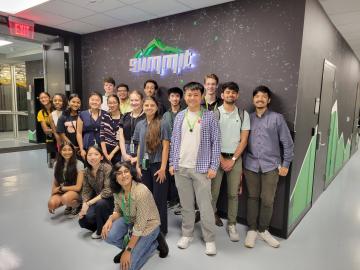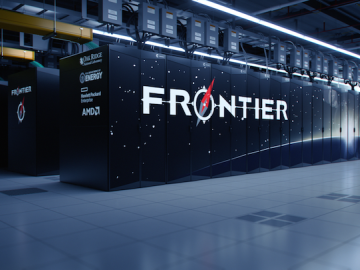Filter News
Area of Research
- (-) Biology and Environment (134)
- (-) Clean Energy (320)
- (-) Supercomputing (194)
- Advanced Manufacturing (20)
- Biological Systems (3)
- Biology and Soft Matter (4)
- Building Technologies (9)
- Chemical and Engineering Materials (4)
- Chemistry and Physics at Interfaces (7)
- Climate and Environmental Systems (11)
- Computational Biology (2)
- Computational Chemistry (5)
- Computational Engineering (3)
- Computer Science (13)
- Data (1)
- Earth Sciences (1)
- Electricity and Smart Grid (2)
- Energy Frontier Research Centers (7)
- Energy Sciences (2)
- Fossil Energy (1)
- Fuel Cycle Science and Technology (2)
- Functional Materials for Energy (8)
- Fusion and Fission (36)
- Fusion Energy (15)
- Geographic Information Science and Technology (1)
- Isotope Development and Production (1)
- Isotopes (26)
- Materials (197)
- Materials for Computing (23)
- Materials Synthesis from Atoms to Systems (8)
- Materials Under Extremes (7)
- Mathematics (1)
- National Security (53)
- Neutron Data Analysis and Visualization (4)
- Neutron Science (107)
- Nuclear Science and Technology (45)
- Nuclear Systems Modeling, Simulation and Validation (2)
- Quantum Condensed Matter (3)
- Quantum information Science (7)
- Renewable Energy (4)
- Sensors and Controls (4)
- Transportation Systems (6)
News Type
News Topics
- 3-D Printing/Advanced Manufacturing (46)
- Advanced Reactors (3)
- Artificial Intelligence (27)
- Big Data (23)
- Bioenergy (46)
- Biology (63)
- Biomedical (23)
- Biotechnology (11)
- Buildings (25)
- Chemical Sciences (9)
- Clean Water (18)
- Climate Change (51)
- Composites (12)
- Computer Science (78)
- Coronavirus (20)
- Critical Materials (7)
- Cybersecurity (7)
- Decarbonization (33)
- Energy Storage (43)
- Environment (108)
- Exascale Computing (15)
- Fossil Energy (1)
- Frontier (14)
- Fusion (1)
- Grid (29)
- High-Performance Computing (33)
- Hydropower (9)
- Machine Learning (13)
- Materials (24)
- Materials Science (24)
- Mathematics (5)
- Mercury (9)
- Microelectronics (1)
- Microscopy (12)
- Nanotechnology (10)
- National Security (5)
- Net Zero (4)
- Neutron Science (8)
- Nuclear Energy (6)
- Partnerships (4)
- Physics (4)
- Polymers (9)
- Quantum Computing (14)
- Quantum Science (14)
- Renewable Energy (1)
- Security (3)
- Simulation (18)
- Software (1)
- Space Exploration (5)
- Statistics (1)
- Summit (30)
- Sustainable Energy (64)
- Transportation (47)
Media Contacts

Electric vehicles can drive longer distances if their lithium-ion batteries deliver more energy in a lighter package. A prime weight-loss candidate is the current collector, a component that often adds 10% to the weight of a battery cell without contributing energy.

Researchers at ORNL became the first to 3D-print large rotating steam turbine blades for generating energy in power plants.

A team of computational scientists at ORNL has generated and released datasets of unprecedented scale that provide the ultraviolet visible spectral properties of over 10 million organic molecules.

Research performed by a team, including scientists from ORNL and Argonne National Laboratory, has resulted in a Best Paper Award at the 19th IEEE International Conference on eScience.

This summer, ORNL welcomed more than 500 students to campus through the lab’s range of internship programs, which are offered in areas such as biology, national security and computing.

Karen White, who works in ORNL’s Neutron Science Directorate, has been honored with a Lifetime Achievement Award.

ORNL's Climate Change Science Institute and the Georgia Institute of Technology hosted a Southeast Decarbonization Workshop in November that drew scientists and representatives from government, industry, non-profits and other organizations to

Scientists at ORNL used their knowledge of complex ecosystem processes, energy systems, human dynamics, computational science and Earth-scale modeling to inform the nation’s latest National Climate Assessment, which draws attention to vulnerabilities and resilience opportunities in every region of the country.

ORNL researchers demonstrated that an additive made from polymers and electrolytes improves the thermal performance and stability of salt hydrate phase change materials, or PCMs, a finding that could advance their integration into carbon-reducing heat pumps.

How the Frontier team broke the exascale barrier to launch a new supercomputing era for scientific discovery.




